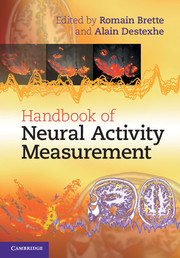Book contents
- Frontmatter
- Contents
- List of contributors
- 1 Introduction
- 2 Electrodes
- 3 Intracellular recording
- 4 Extracellular spikes and CSD
- 5 Local field potentials
- 6 EEG and MEG: forward modeling
- 7 MEG and EEG: source estimation
- 8 Intrinsic signal optical imaging
- 9 Voltage-sensitive dye imaging
- 10 Calcium imaging
- 11 Functional magnetic resonance imaging
- 12 Perspectives
- Plate section
- References
11 - Functional magnetic resonance imaging
Published online by Cambridge University Press: 05 October 2012
- Frontmatter
- Contents
- List of contributors
- 1 Introduction
- 2 Electrodes
- 3 Intracellular recording
- 4 Extracellular spikes and CSD
- 5 Local field potentials
- 6 EEG and MEG: forward modeling
- 7 MEG and EEG: source estimation
- 8 Intrinsic signal optical imaging
- 9 Voltage-sensitive dye imaging
- 10 Calcium imaging
- 11 Functional magnetic resonance imaging
- 12 Perspectives
- Plate section
- References
Summary
Introduction
Functional magnetic resonance imaging (fMRI) allows the non-invasive measurement of neural activity nearly everywhere in the brain. The structural predecessor, MRI, was invented in the early 1970s (Lauterbur, 1973) and has been used clinically since the mid-1980s to provide high-resolution structural images of body parts, including rapid successions of images for example of the beating heart. However, it was the advent of blood oxygenation level dependent (BOLD) functional imaging developed first by Ogawa et al. (1990) that made the method crucial especially for the human neurosciences, leading to a vast expansion of both the method of fMRI as well as the field of human neurosciences. fMRI is now a mainstay of neuroscience research and by far the most widespread method for investigations of neural function in the human brain as it is entirely harmless, relatively easy to use, and the data are relatively straightforward to analyze. It is therefore no surprise that fMRI has provided a wealth of information about the functional organization of the human brain. While many publications initially confirmed knowledge derived from invasive animal experiments or from clinical studies, it is now frequently fMRI that opens up a new field of investigation that is then later followed up by invasive methods.
It is important to note that fMRI does not measure electrical or neurochemical activity directly. Physically, it relies on decay time-constants of water protons, which are affected by brain tissue and the concentration of deoxyhemoglobin.
- Type
- Chapter
- Information
- Handbook of Neural Activity Measurement , pp. 410 - 469Publisher: Cambridge University PressPrint publication year: 2012



